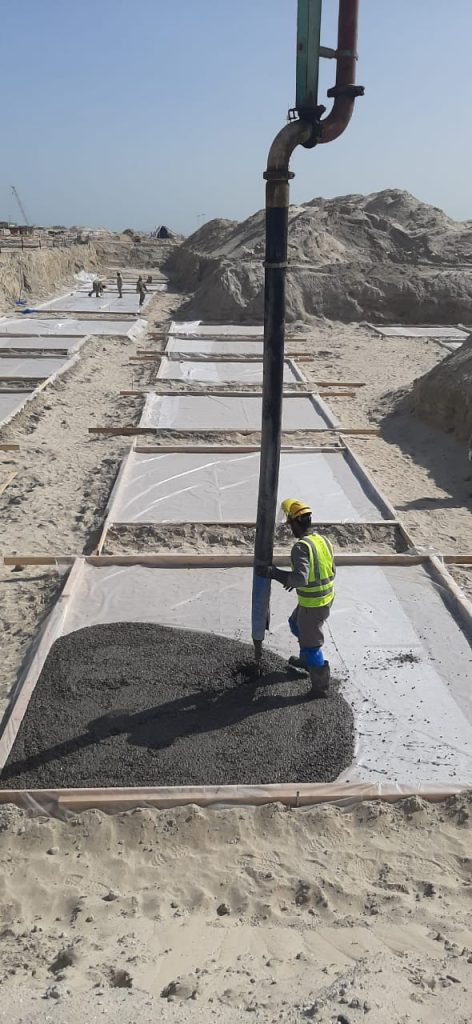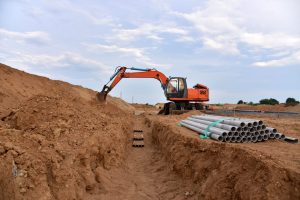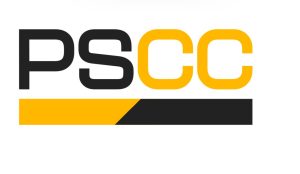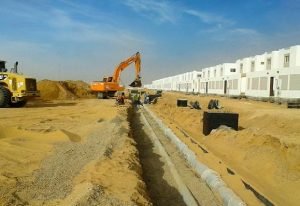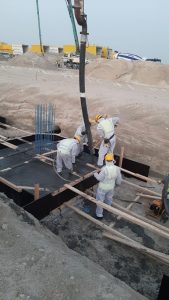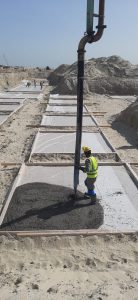Mastering Concrete Work in Construction: A Comprehensive Guide
Book Chapters:
- Understanding Concrete: Its Properties and Composition
- Concrete Mixing: Proportions and Techniques
- Reinforcement in Concrete: Types and Placement
- Formwork and Shuttering for Concrete Structures
- Placing and Compacting Concrete: Best Practices
- Curing and Finishing Concrete: Importance and Methods
- Decorative Concrete: Stamped, Stained, and Polished Finishes
- Repairing and Resurfacing Concrete: Techniques and Materials
- Preparing Subgrades for Concrete: Soil Compaction and Grading
- Precast Concrete: Types and Advantages
- Concrete Pumping: Equipment and Safety Measures
- Concrete Testing: Quality Control and Assurance
- Structural Design with Concrete: Principles and Considerations
- Environmental Impact of Concrete: Sustainable Solutions
- Future of Concrete: New Technologies and Innovations
Book Introduction: Concrete is one of the most important and widely used materials in construction. It is durable, versatile, and offers a wide range of structural and aesthetic options. From building foundations and walls to roads and bridges, concrete is an essential element of modern infrastructure. However, working with concrete requires a specific set of skills, knowledge, and experience. Mastering Concrete Work in Construction is a comprehensive guide that provides readers with a complete understanding of concrete, its properties, composition, mixing, and placement techniques, as well as the best practices for curing, finishing, and decorating it. The book covers all aspects of concrete work, from preparing subgrades to designing structures, testing and ensuring quality, and exploring sustainable solutions. With detailed information and step-by-step instructions, this guide is an indispensable resource for professionals in the construction industry, as well as students and anyone interested in learning about the art and science of concrete.
Chapter 1: Understanding Concrete: Its Properties and Composition
Concrete is a composite material made of cement, water, aggregates (such as sand, gravel, or crushed stone), and often other additives or admixtures. Understanding the properties and composition of concrete is essential to mastering concrete work in construction. In this chapter, we will explore the basics of concrete, its ingredients, and the factors that affect its strength, durability, and workability.
The first section of this chapter will introduce the basic concepts of concrete, such as its chemical and physical properties, and its role in construction. We will cover the different types of cement, including Portland cement, blended cement, and specialty cement, as well as the chemical reactions that occur during the curing process. We will also discuss the role of water in the mix, including the water-cement ratio, and the importance of controlling the moisture content during the curing phase.
The second section of this chapter will focus on aggregates, which are the largest component of concrete by volume. We will cover the types of aggregates used in concrete, such as natural and manufactured sands, gravels, and crushed stones, as well as the importance of gradation and quality control. We will also discuss the effect of aggregate properties on concrete strength, workability, and durability.
The third section of this chapter will explore the role of additives and admixtures in concrete. These materials are used to modify the properties of fresh and hardened concrete, such as reducing water content, increasing workability, or improving strength and durability. We will cover the different types of additives and admixtures, including air-entraining agents, water-reducing agents, retarding agents, accelerating agents, and pozzolanic materials.
The final section of this chapter will discuss the factors that affect the workability and strength of concrete, such as mix design, placement methods, curing techniques, and environmental conditions. We will
The mix design of concrete is critical to achieving the desired properties and performance of the final product. We will cover the different types of mix designs, such as standard mixes, high-strength mixes, and lightweight mixes, as well as the importance of proportioning and batching the ingredients correctly.
The placement method of concrete is also crucial to its success. In this section, we will discuss the different methods of placing concrete, such as pouring, pumping, and conveying, as well as the best practices for consolidating and finishing the surface.
Curing is the process of maintaining the moisture content and temperature of the concrete during the early stages of hardening, to ensure that it achieves its desired strength and durability. We will cover the different methods of curing, such as wet curing, membrane curing, and curing compounds, as well as the importance of curing time and temperature.
Finally, environmental conditions can have a significant impact on the performance and durability of concrete. In this section, we will discuss the effect of temperature, humidity, wind, and other weather conditions on concrete, as well as the best practices for protecting concrete during extreme weather events.
By the end of this chapter, readers will have a comprehensive understanding of the properties and composition of concrete, as well as the factors that affect its strength, durability, and workability. This knowledge is essential for anyone working with concrete in the construction industry, from engineers and architects to contractors and laborers. With this foundation, readers can move on to the practical skills and techniq
Chapter 2: Concrete Tools and Equipment
In this chapter, we will cover the tools and equipment necessary for working with concrete, from basic hand tools to advanced machinery. We will discuss the different types of hand tools, such as trowels, floats, and screeds, as well as their uses and maintenance. We will also cover the safety precautions that must be taken when using hand tools.
For larger concrete projects, machinery and equipment are necessary to ensure efficiency and quality. We will discuss the different types of equipment, such as mixers, pumps, and vibrators, as well as their capabilities and limitations. We will also cover the safety precautions that must be taken when operating machinery.
In addition to hand tools and machinery, there are also various types of formwork and shoring that are necessary for creating the desired shape and support of the concrete. We will discuss the different types of formwork, such as wood, steel, and plastic, as well as the best practices for installing and removing formwork. We will also cover the importance of shoring and bracing for ensuring the safety and stability of the formwork.
By the end of this chapter, readers will have a comprehensive understanding of the tools and equipment necessary for working with concrete, as well as the safety precautions that must be taken when using them. This knowledge is essential for anyone working with concrete in the construction industry, from engineers and architects to contractors and laborers. With this knowledge, readers can move on to the practical skills and techniques covered in the following chapters.
Chapter 3: Concrete Placement Techniques
In this chapter, we will cover the different techniques used to place and shape concrete, from traditional pouring to more advanced methods. We will discuss the advantages and limitations of each technique, as well as the safety precautions that must be taken during placement.
Traditional pouring involves pouring concrete from a truck into a prepared formwork, and then consolidating and finishing the surface. We will discuss the best practices for preparing the formwork, placing the concrete, and consolidating and finishing the surface.
Pumping is another popular method for placing concrete, especially in hard-to-reach areas or on elevated surfaces. We will discuss the different types of pumps, such as boom pumps and line pumps, as well as the best practices for setting up and operating a concrete pump.
Conveying is another method for placing concrete, which involves using a conveyor belt or bucket to transport the concrete from the truck to the formwork. We will discuss the best practices for setting up and operating a conveyor system, as well as the advantages and limitations of this method.
In addition to these traditional methods, there are also more advanced techniques for placing and shaping concrete, such as shotcrete and precast concrete. We will discuss the advantages and limitations of each of these methods, as well as the best practices for preparing and installing them.
By the end of this chapter, readers will have a comprehensive understanding of the different techniques used to place and shape concrete, as well as the safety precautions that must be taken during placement. This knowledge is essential for anyone working with concrete in the construction industry, from engineers and architects to contractors and laborers. With this knowledge, readers can move on to the practical skills and techniques covered in the following chapters.

